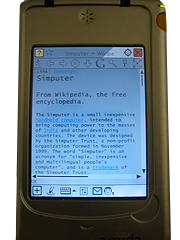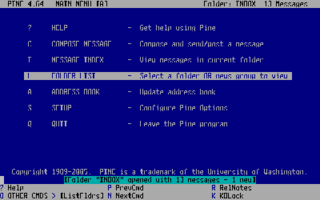The Simputer General Public License, or the SGPL is a hardware distribution public copyright license drafted specifically for the purpose of distributing Simputers. As a license it has been loosely modeled on the GPL but in substance it is very different.
A public license or public copyright license is a license by which a copyright holder as licensor can grant additional copyright permissions to any and all persons in the general public as licensees. By applying a public license to a work, provided that the licensees obey the terms and conditions of the license, copyright holders give permission for others to copy or change their work in ways that would otherwise infringe copyright law.

The Simputer was a self-contained, open hardware Linux-based handheld computer, first released in 2002. Developed in, and primarily distributed within India, the product was envisioned as a low-cost alternative to personal computers. With initial goals of selling 50,000 simputers, the project had sold only about 4,000 units by 2005, and has been called a failure by news sources.

The GNU General Public License is a widely used free software license, which guarantees end users the freedom to run, study, share and modify the software. The license was originally written by Richard Stallman of the Free Software Foundation (FSF) for the GNU Project, and grants the recipients of a computer program the rights of the Free Software Definition. The GPL is a copyleft license, which means that derivative work can only be distributed under the same license terms. This is in distinction to permissive free software licenses, of which the BSD licenses and the MIT License are widely used examples. GPL was the first copyleft license for general use.
The Simputer specifications are released under the terms and conditions of the SGPL. This license permits the user to build a Simputer based upon the specifications and to use the Simputer for non-commercial purposes. Any modifications made to the Simputer specifications may be used exclusively by the person making those modifications with no obligation to release the same to the public domain. However, within 12 months from the date of the first public sale of the Simputer based on these modified specifications, the person who created these modified specifications is bound to disclose the specifications to the Simputer Trust.
The Simputers manufactured under the SGPL are required to be certified by the Simputer Trust before they are allowed to be sold under the Simputer trademark. In order to be so certified they must fulfill the Core Simputer Specifications as disclosed on the simputer website.
All Simputers developed under the specifications must be distributed under the same terms as the SGPL.

Free software or libre software is computer software distributed under terms that allow users to run the software for any purpose as well as to study, change, and distribute it and any adapted versions. Free software is a matter of liberty, not price: users—individually or in cooperation with computer programmers—are free to do what they want with their copies of a free software regardless of how much is paid to obtain the program. Computer programs are deemed free insofar as they give users ultimate control over the first, thereby allowing them to control what their devices are programmed to do.

The GNU Lesser General Public License (LGPL) is a free-software license published by the Free Software Foundation (FSF). The license allows developers and companies to use and integrate a software component released under the LGPL into their own software without being required by the terms of a strong copyleft license to release the source code of their own components. However, any developer who modifies an LGPL-covered component is required to make their modified version available under the same LGPL license. For proprietary software, code under the LGPL is usually used in the form of a shared library, so that there is a clear separation between the proprietary and LGPL components. The LGPL is primarily used for software libraries, although it is also used by some stand-alone applications.
An open-source license is a type of license for computer software and other products that allows the source code, blueprint or design to be used, modified and/or shared under defined terms and conditions. This allows end users and commercial companies to review and modify the source code, blueprint or design for their own customization, curiosity or troubleshooting needs. Open-source licensed software is mostly available free of charge, though this does not necessarily have to be the case. Licenses which only permit non-commercial redistribution or modification of the source code for personal use only are generally not considered as open-source licenses. However, open-source licenses may have some restrictions, particularly regarding the expression of respect to the origin of software, such as a requirement to preserve the name of the authors and a copyright statement within the code, or a requirement to redistribute the licensed software only under the same license. One popular set of open-source software licenses are those approved by the Open Source Initiative (OSI) based on their Open Source Definition (OSD).
The Open Source Definition is a document published by the Open Source Initiative, to determine whether a software license can be labeled with the open-source certification mark.

Pine is a freeware, text-based email client which was developed at the University of Washington. The first version was written in 1989, and announced to the public in March 1992. Source code was available for only the Unix version under a license written by the University of Washington. Pine is no longer under development, and has been replaced by the Alpine client, which is available under the Apache License.
Trusted Computing (TC) is a technology developed and promoted by the Trusted Computing Group. The term is taken from the field of trusted systems and has a specialized meaning. With Trusted Computing, the computer will consistently behave in expected ways, and those behaviors will be enforced by computer hardware and software. Enforcing this behavior is achieved by loading the hardware with a unique encryption key inaccessible to the rest of the system.

The Apache License is a permissive free software license written by the Apache Software Foundation (ASF). The Apache License, Version 2.0 requires preservation of the copyright notice and disclaimer. Like other free software licenses, the license allows the user of the software the freedom to use the software for any purpose, to distribute it, to modify it, and to distribute modified versions of the software, under the terms of the license, without concern for royalties. This makes the Apache License a FRAND-RF license. The ASF and its projects release the software they produce under the Apache License. The license is also used by many non-ASF projects.
An open standard is a standard that is publicly available and has various rights to use associated with it, and may also have various properties of how it was designed. There is no single definition and interpretations vary with usage.
A GPL linking exception modifies the GNU General Public License (GPL) in a way that enables software projects which provide library code to be "linked to" the programs that use them, without applying the full terms of the GPL to the using program. Linking is the technical process of connecting code in a library to the using code, to produce a single executable file. It is performed either at compile time or run-time in order to produce functional machine-readable code. There is a public perception, so far unsupported by any legal precedent or citation, that without applying the linking exception, a program linked to GPL library code may only be distributed under a GPL-compatible license. The license of the GNU Classpath project explicitly includes a statement to that effect.
Source-available software is software released through a source code distribution model that includes arrangements where the source can be viewed, and in some cases modified, but without necessarily meeting the criteria to be called open-source. The licenses associated with the offerings range from allowing code to be viewed for reference, to allowing code to be modified and redistributed for both commercial and non-commercial purposes.
A software license is a legal instrument governing the use or redistribution of software. Under United States copyright law, all software is copyright protected, in both source code and object code forms. The only exception is software in the public domain. A typical software license grants the licensee, typically an end-user, permission to use one or more copies of software in ways where such a use would otherwise potentially constitute copyright infringement of the software owner's exclusive rights under copyright.
The Sun Industry Standards Source License (SISSL) is now a retired free and open source license, recognized as such by the Free Software Foundation and the Open Source Initiative (OSI). Under SISSL, developers could modify and distribute source code and derived binaries freely. Furthermore, developers could choose to keep their modifications private or make them public. However, the SISSL is unique among OSI-approved licenses in requiring that "The Modifications which You create must comply with all requirements set out by the Standards body in effect one hundred twenty (120) days before You ship the Contributor Version." If the Modifications do not comply, SISSL becomes a copyleft license, and source must be published "under the same terms as this license [SISSL] on a royalty-free basis within thirty (30) days."
The University of Illinois/NCSA Open Source License, or UIUC license, is a permissive free software license, based on the MIT/X11 license and the 3-clause BSD license. By combining parts of these two licenses, it attempts to be clearer and more concise than either.
The Common Public Attribution License ("CPAL") is a free software license approved by the Open Source Initiative in 2007. Its purpose is to be a general license for software distributed over a network. It is based on the Mozilla Public License, but it adds an attribution term paraphrased below:
[…] the Original Developer may include […] a requirement that each time an Executable and Source Code or a Larger Work is launched or initially run […] a prominent display of the Original Developer's Attribution Information […] must occur on the graphic user interface employed by the end user to access such Covered Code […]

Copyleft, distinguished from copyright, is the practice of offering people the right to freely distribute copies and modified versions of a work with the stipulation that the same rights be preserved in derivative works created later. Copyleft software licenses are considered protective or reciprocal, as contrasted with permissive free-software licenses.
The TAPR Open Hardware License is a license used in open-source hardware projects. It was created by Tucson Amateur Packet Radio (TAPR), an international amateur radio organization. Version 1.0 was published on May 25, 2007.
The zlib license is a permissive free software license which defines the terms under which the zlib software library can be distributed. It is also used by many other free software packages. The libpng library uses a similar license sometimes referred interchangeably as the zlib/libpng license.
Software categories are groups of software. They allow software to be understood in terms of those categories instead of the particularities of each package. Different classification schemes consider different aspects of software.






